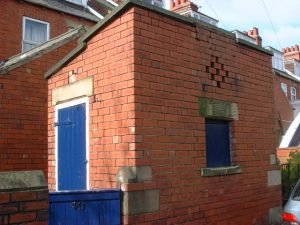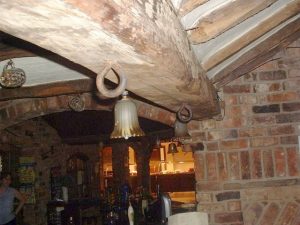Pre-war public health legislation was framed to improve hygiene by preventing the local slaughter of animals from allotments and ordering that such action should take place in approved slaughter houses. Difficult to enforce with the thousands of allotment holders who reared pigs. Impossible to enforce during wartime when all were being encouraged to grow and produce food for the war effort. Allotment husbandry of pigs continued after the war and along with it remained the need to slaughter the animals locally for economic reasons.
My wife tells me the amusing story of having to go to the telephone box as a twelve year old to ring for the man to bring the boar to the sow because her Father couldn’t use the call box.
Competition was keen in those days for left over food from the school kitchen and the pit canteen.
When it came to needing the bacon the cost of sending a single or small number of animals to an abattoir was economically unviable and the practice of local slaughter continued for some time.
Picture the view for three ten year olds from the top of a converted midden, Len Cox had unloaded a large half wooden vat which was being filled with buckets of hot water. The pig was led out of the sty with the aid of a ‘twitch’ to an area covered with fresh straw. The animal was squealing, it must have known its fate the squealing stopped suddenly when the humane killer was applied to the brain. The animal although dead would continue to give powerful nervous twitches of the limbs and the two Cox brothers had to be careful whilst lifting the carcass onto a one wheeled bench known as a ‘stretch’ and then loaded into the vat. A slash on the throat provided a gush of bright red blood into a container which would go to making black pudding. Now the two brothers used circular scrapers not unlike pastry cutters to shave the hair off the pigs skin, which would in time make some great ‘crackling’.
The carcass was now salted and wheeled into an outhouse to be hung by the back trotters to enable it to be split and disembowelled (nothing was wasted) and left overnight before the big knives were out for quartering the next day. Gripping viewing for a few ten year olds.
A slaughterman had to pay one shilling annually for a licence and the pigs owner was required to surrender a ration book on completion. Remember during the war and immediately post war, everybody, housewives included, waited eagerly for some bacon and pork to supplement the rations….
Thanks to Keith Cox and Freddie Worth for providing the names of some of the items used including a ‘Cameral’ which was the joist with the eyes or hooks that the pig was suspended on.
To view one of these, call in the Bridge Inn at Whitwood and see the large section joist supporting one of the bars. The late landlord, Harry Topliss told me that the timber was obtained from a derelict property at Methley Junction. Which I guess could have been Pindergreen Farm.